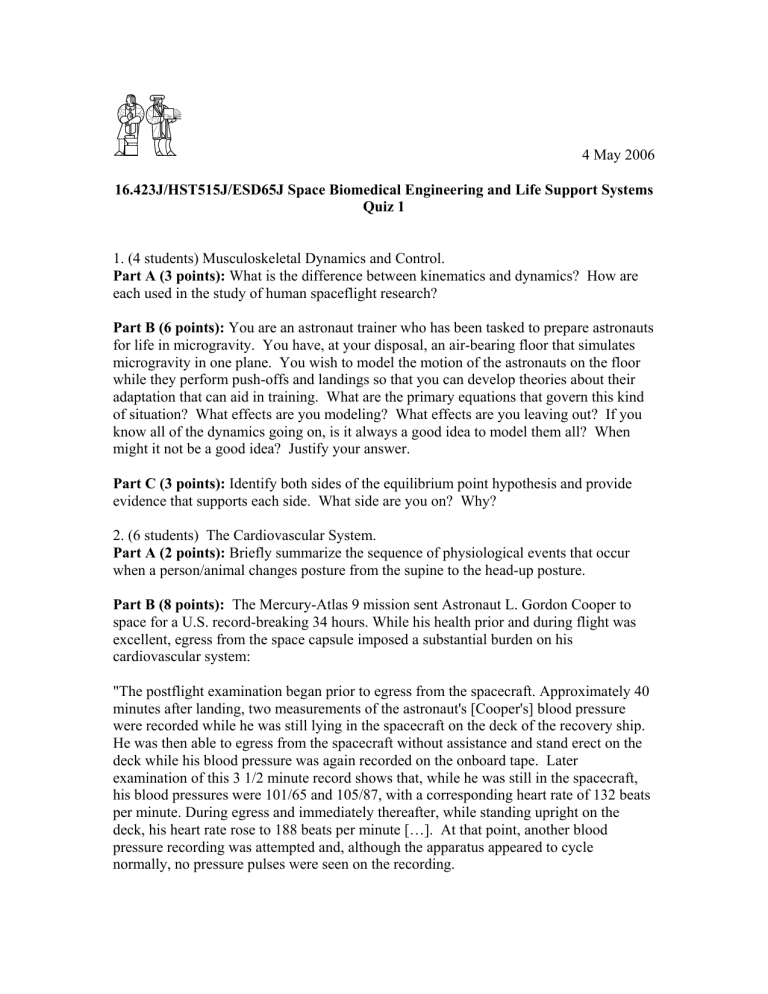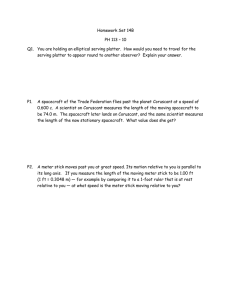4 May 2006 1. (4 students) Musculoskeletal Dynamics and Control.

4 May 2006
16.423J/HST515J/ESD65J Space Biomedical Engineering and Life Support Systems
Quiz 1
1. (4 students) Musculoskeletal Dynamics and Control.
Part A (3 points): What is the difference between kinematics and dynamics? How are each used in the study of human spaceflight research?
Part B (6 points): You are an astronaut trainer who has been tasked to prepare astronauts for life in microgravity. You have, at your disposal, an air-bearing floor that simulates microgravity in one plane. You wish to model the motion of the astronauts on the floor while they perform push-offs and landings so that you can develop theories about their adaptation that can aid in training. What are the primary equations that govern this kind of situation? What effects are you modeling? What effects are you leaving out? If you know all of the dynamics going on, is it always a good idea to model them all? When might it not be a good idea? Justify your answer.
Part C (3 points): Identify both sides of the equilibrium point hypothesis and provide evidence that supports each side. What side are you on? Why?
2. (6 students) The Cardiovascular System.
Part A (2 points): Briefly summarize the sequence of physiological events that occur when a person/animal changes posture from the supine to the head-up posture.
Part B (8 points): The Mercury-Atlas 9 mission sent Astronaut L. Gordon Cooper to space for a U.S. record-breaking 34 hours. While his health prior and during flight was excellent, egress from the space capsule imposed a substantial burden on his cardiovascular system:
"The postflight examination began prior to egress from the spacecraft. Approximately 40 minutes after landing, two measurements of the astronaut's [Cooper's] blood pressure were recorded while he was still lying in the spacecraft on the deck of the recovery ship.
He was then able to egress from the spacecraft without assistance and stand erect on the deck while his blood pressure was again recorded on the onboard tape. Later examination of this 3 1/2 minute record shows that, while he was still in the spacecraft, his blood pressures were 101/65 and 105/87, with a corresponding heart rate of 132 beats per minute. During egress and immediately thereafter, while standing upright on the deck, his heart rate rose to 188 beats per minute […]. At that point, another blood pressure recording was attempted and, although the apparatus appeared to cycle normally, no pressure pulses were seen on the recording.
His heart then returned to a normal sinus rhythm with a rate of 92 beats per minute at sensor disconnect.
After standing on the deck for approximately a minute, the pilot began to look pale and, although his face was already wet, new beads of perspiration appeared on his forehead.
He swayed slightly and reported symptoms of impending loss of consciousness including lightheadedness, dimming of vision, and tingling of his feet and legs. The cable was immediately disconnected and, with support at each arm, he began to walk away from the spacecraft. After a few steps, 5 to 10 seconds later, he was able to walk without assistance and to salute the ship's commanding officer."
Taken from: Manned Spacecraft Center (U.S.). Mercury Project Summary, Including
Results from the Fourth Manned Orbital Flight. NASA SP-45, 1963.
B-1 (3 points): Briefly summarize all of astronaut Cooper's symptoms that might indicate the presence of orthostatic intolerance.
B-2 (3 points): On the basis of your knowledge of cardiovascular physiology, name three possible mechanisms of orthostatic intolerance after return from spaceflight.
B-3 (2 points): Name three possible countermeasures against post-spaceflight orthostatic intolerance.
3. (3 students) Human Spaceflight: Extravehicular Activity (EVA) Systems Design.
Part A (5 points) Give a conceptual design for an advanced planetary EVA system (e.g., lunar,
1/6 G OR Mars, 3/8 G). You may touch on life support and pressure, but primarily focus your answer on the design issues of an advanced suit and exploration system capability.
Part B (5 points) Discuss advanced suit requirements and the trade-offs between an advanced planetary suit design and current EVA EMU (microgravity) suits that would have to be resolved in advanced designs. You might also want to mention human–robotic capabilities for planetary exploration.
Recommendations for Quiz 2 : Work efficiently in your team for 45 minutes to: 1) organize yourselves 2) work on your aspect of the answer 3) come together to prepare comprehensive written and oral answers , and 4) select 1 or team members to brief the answer to the entire class. There will be 3 briefings in-class from 10:20 am – 10:55 am
(Dynamics = 8 min; Cardiovascular = 12; EVA = 6 min). Grades will be based on the written and oral team answers as well as individual grades. All students will be asked to confidentially grade themselves and their team members’ contributions.
Remember: Illustrations of concepts/answers are very beneficial! Cite and list any references.



